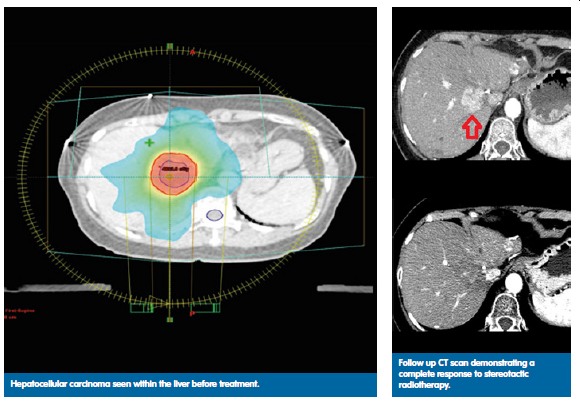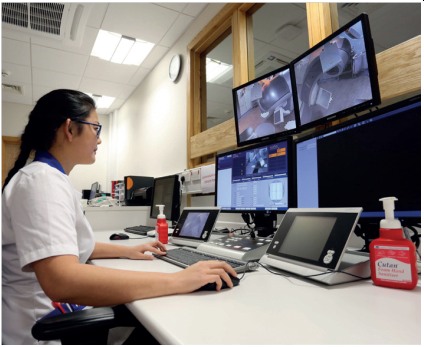Radiotherapy
Radiotherapy can be used for treating cancerous and non-cancerous (benign) tumours.
Radiotherapy uses high energy X-ray photons carefully calculated to target a specific area of the body. The X-ray photons cause damage to the cell’s DNA in this area. Healthy cells have the ability to repair, whereas cancer cells cannot recover.
Radiotherapy is given over a number of treatments, to allow healthy cells a chance to recover. Each patient’s treatment schedule is different, your doctor will explain your treatment schedule to you.
Correcting the myths
- Radiotherapy does not hurt
- There is no ‘zap’, ‘jolt’ or ‘electric shock’ seen or felt
- You will not be radioactive after treatment
- You will not pose a danger to children or pregnant women
- Hair loss only occurs in the treated area and is not always permanent
Treatment Planning
Radiotherapy is individually planned for all patients based on a CT scan of the area of the body being treated.
Supportive equipment is used to create a reproducible position that can be replicated each day for treatment.
You will be given small tattoo marks which are used as reference points for daily positioning.
If undergoing Head and Neck Radiotherapy, you will have a mask made. This is worn for your CT planning scan and every treatment session. See making the mask video.
There is normally a few weeks in between the planning appointment and the start of treatment.
Treatment delivery
In the video below, Radiographers Hannah and Mary show us the different equipment used within radiotherapy treatment.
For each treatment session, you will be positioned as you were for your planning CT scan.
Your tattoo reference marks will be used to ensure correct alignment. This is achieved using light lasers in the treatment room and movement of the treatment couch.
Once the radiographers are happy with your positioning, they will leave the room. They may then take images to confirm that you are in the correct position before treatment delivery.
Imaging is repeated regularly during treatment for positioning purposes, unfortunately we cannot assess treatment response from these images.
The machine is controlled remotely from the control area outside the treatment room. You are observed at all times on CCTV and intercom can be used.
Treatment can be interrupted if you need to stop treatment for any reason and can then be resumed.
Appointment times vary between 15 minutes to an hour depending on the treatment you are receiving. This will be discussed with you.
On Treatment Review
You will be seen regularly throughout your treatment in the review clinic.
The review and information and support team are a specialist team of radiographers who can assess and manage Radiotherapy side effects.
They can prescribe medication to help side effects of treatment and discuss any emotional and practical concerns you may have. They can also ensure appropriate referrals to supportive services are put in place should you require them.
Site specific booklets are available which includes information about treatment side effects. These can be found in the information leaflet section of the website.
Stereotactic radiotherapy
Stereotactic radiotherapy is one of the most up to date radiotherapy techniques for treating cancers. It is unique in that it delivers high doses of radiation to the tumour with great accuracy, destroying cancer cells but, sparing surrounding normal healthy tissue and reducing side effects.
This technique can be used for many different cancer sites from lung cancers, as an alternative to the surgeon’s knife, or areas where the cancer has spread to in a variety of sites around the body. Its potential to cure metastatic tumour spread has given hope to patients that have traditionally only ever been treated with palliative therapies.

Velindre Cancer Centre has made great strides in developing a stereotactic service and has already made progress in treating lung and liver cancers, tumours of the brain and benign tumours of the skull base. Historically all patients with benign skull base tumours were sent to cancer centres over the boarder but now over the last year we can treat them successfully back here in Velindre Cancer Centre.
However much work is needed as we know this technique can be used in many more cancer sites and with the enthusiasm and knowledge that the staff of Velindre Cancer Centre prides themselves on, we hope to bring this technique to many more patients in Wales.
Could you benefit from Stereotactic Body Radiotherapy?

There are many strict criteria for such treatment as there are risks and side effects associated with its use. Every patient being considered for this treatment undergoes extensive discussions, planning and monitoring through a big team of specialists to ensure only the correct patients are selected and the treatment is of a high standard delivered in a safe and effective way. Please don’t hesitate to discuss stereotactic radiotherapy with your Oncologist if you think you could be suitable.
Useful contact numbers
If you are currently on treatment please contact your treatment machine - their telephone number is on the front of your treatment appointment card. Or contact Radiotherapy Reception on 02920615888 ext 6434/6433 available 8am-6pm Monday to Friday.
You can speak to the Review and Information and Support team regarding any treatment related side effects on 02920615888 ext 6421 available 8.30am-5pm Monday to Friday.
If you have not started your Radiotherapy treatment and have questions regarding appointments please contact Radiotherapy Booking on 02920615888 ext 6134/6836 available 8.30am-5pm Monday to Friday.
For queries regarding planning appointments, please contact Radiotherapy Planning on 02920615888 ext 6150 available 8.30am-5pm Monday to Friday.
If you are unwell outside of these hours or over the weekend, please contact the Treatment Helpline 02920 615 888 (available 24/7).
To book onto the 'Getting Started with Radiotherapy' sessions, please call 029 2061 5888 ext. 6421



